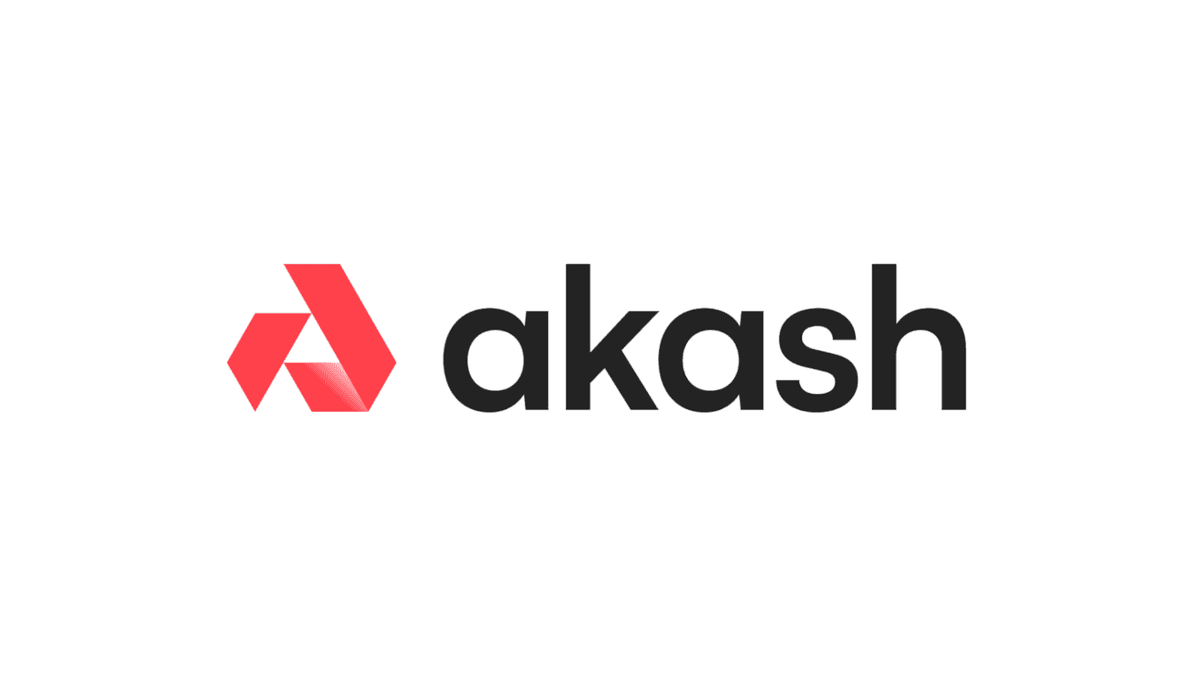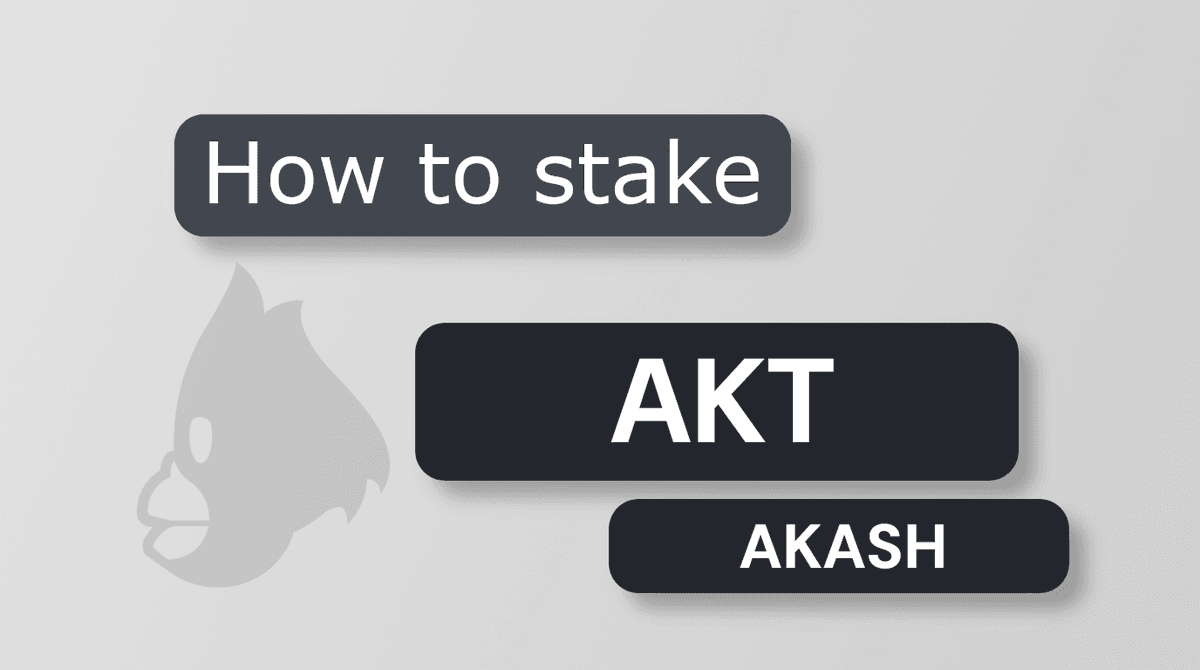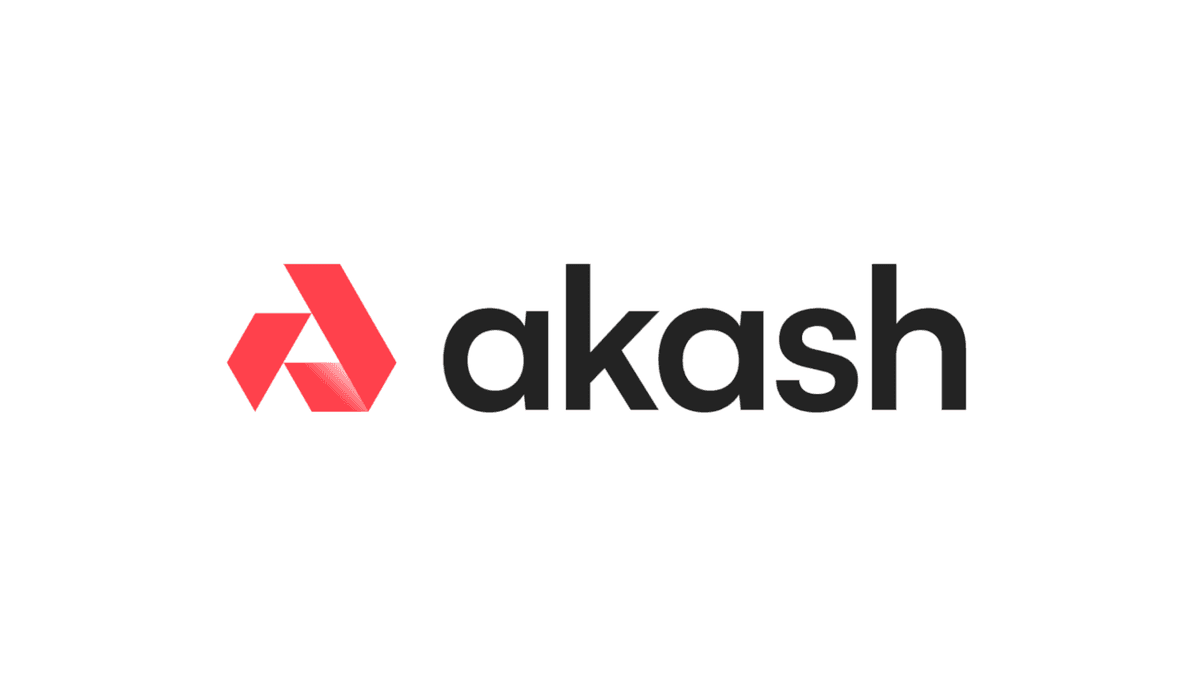Key Takeaways
- Decentralized Cloud Platform: Akash offers a decentralized marketplace for cloud computing, connecting resource providers with developers.
- Cross-Chain Compatibility: Built on Cosmos, Akash integrates with various blockchain networks, enhancing interoperability.
- Cost efficiency: Akash provides cloud services at lower costs compared to centralized providers.
- Sustainable growth: The Akash marketplace promotes scalable, sustainable resource usage across various user types.
- Developer-friendly: Akash supports the development of decentralized applications (dApps) in AI, machine learning, and niches of all shapes and sizes.
Introduction to the Akash Network Ecosystem
Akash is a Decentralized Physical Infrastructure Network (DePIN) built to offer decentralized compute through an incentivized marketplace structure.
Although the Akash ecosystem is connected to a wide range of sovereign blockchain ecosystems and independent Layer 1 and Layer 2 networks, its main association is to the Cosmos ecosystem.
Because of the design of the Inter-Blockchain Communication Protocol (IBC), the Cosmos SDK, and other important constructs, similarly to other chains operating atop the larger Cosmos Network, Akash is able to interoperate and share data and assets with all chains within the greater Cosmos ecosystem.
In many respects, this interoperability is realized at the network level (sharing data between chains), application level (offering dApp interconnectivity between various Cosmos chains), and asset level (through the exchangeability of various Cosmos asset types via the Keplr Wallet and IBC).
The long arduous process to help these many features come to fruition between Cosmos’ many chains has been a painstaking multi-year process. Akash is no different; its relationship with the Cosmos ecosystem began way back in 2018 when Akash initially began building on the Cosmos SDK.
To provide more context, let's touch on several of the most important ecosystem projects and integrations that Akash employs:
- Venice AI - similar to a decentralized version of Google’s Gemini or Chat GPT, Venice AI is a platform that leverages artificial intelligence to create, manage, and optimize visual content, focused particularly on video editing and media production
- Brev - recently acquired by AI and computing giant Nvidia, Brev is a startup that specializes in GPUs and the development of AI-powered tools for automating and streamlining software development, particularly focusing on improving developer workflows
- Morpheus - a startup dedicated to the development of machine learning models and tools, Morpheus is focused on the creation of efficient, scalable AI solutions for numerous industries
- Prime Intellect - a platform that provides AI-driven solutions for businesses, Prime Intellect specializes in data analysis, intelligent automation, and predictive insights to enhance operational efficiency and decision-making
- Nebula Block: as a platform that offers AI-powered tools for automating and optimizing blockchain-based processes, Nebula Block is primarily focused on enhancing security, efficiency, and scalability in decentralized applications
- Osmosis - linked directly to Keplr wallet, Osmosis is the largest decentralized exchange (DEX) within the Cosmos ecosystem and provides a liquidity funnel for AKT and a host of Cosmos assets between all Cosmos chains via IBC.
- Kava Network - a Cosmos-native blockchain built to provide a multifunctional DeFi suite, Kava Network offers a decentralized money market, a token swap service, as well as liquid staking, perpetuals futures trading, traditional staking, and more along with its own Tether-enabled stablecoin, USDX.
- Helium- a DePIN and IoT network built on Solana, Helium exhibits numerous potential applications including those related to smart cities, wireless mobile phone connectivity, network-enabled hotspot mining, supply chain management and logistics, smart monitoring, smart agriculture, and more.
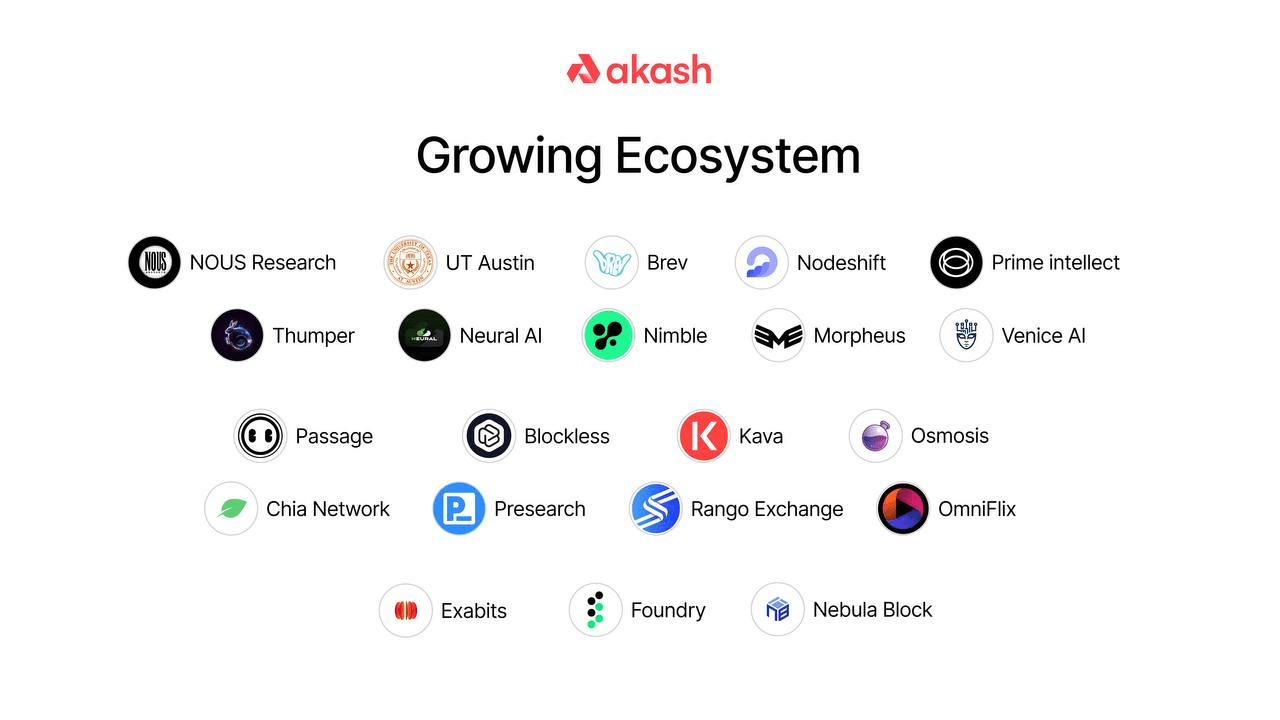
Additional applications deployable on Akash include those for blogging, gaming, database and administration, hosting, continuous integration, project management, tooling, wallets, Cosmos SDK development, media, data visualization, and other utilities within an ever-growing landscape of sectors.
In the event you're interested in learning more about the infrastructure that many of these product and service integrations employ to support the great Akash Network, consider diving into our blog post that goes over Akash’s technical architecture in more detail.
Akash Roadmap and Future Initiatives
The Akash Network has had a long and storied history to reach its current point. This has led the network to gradually increase its maturity as the platform's adoption grows.
However, like most crypto- and blockchain-focused cloud computing platforms, Akash is quite small and has yet to gain even a fraction of the cloud’s total global market share compared to its larger centralized counterparts such as AWS and others. Regardless, let's look at some of the project’s past development milestones:
Previous Roadmap Milestones
- 2014: Work on what would become the first version of the Akash Network is initiated by Akash founders Greg Osuri and Adam Bozanich.
- June 2015: The entity that would later go on to develop the Akash Network, Overclock Labs (originally Ovrclk Inc.) is registered in Delaware.
- December 2016: The initial version of the serverless Kubernetes-enabled edge computing platform DISCO (Distributed Infrastructure for Serverless Computing Operations) is launched by Overclock.
- June 2017: The possibility of adding an open market to DISCO is initially conceived. This open market known as “Photon,” would later become the Akash Network.
- November 2017: The initial version of the Akash Technical Paper is released, with the project still being known as Photon during this phase.
- January 2019: After raising two separate funding rounds in 2016 and 2018 respectively, the first prototype of the Tendermint-specific Akash Network is released as a devnet.
- September 2019: Overclock Labs releases the Akash Economics Whitepaper, outlining the tokenomics of Akash Network's utility token (AKT) to help secure the network.
- September 2020: Akash Network’s Mainnet 1 launches, leveraging staking for the first time, bringing with it the initial release of the AKT token via the network’s token generation event (TGE).
- March 2021: Akash Network's Mainnet 2 launches, debuting the network’s marketplace functionality that defines the Akash platform we know today.
- April 2022 to present: Beginning with Akash Mainnet 3, several Akash Network mainnet upgrades launched over the past year-and-a-half, all consisting of various newly developed upgrades and functionalities.
Although the platform has always been open source, in late 2022 the Akash Network chose to become radically open-source.

Case and point, as of May 2024, the Akash Network is made up of more than 500 global contributors, with all platform changes being shaped by the network's community-led governance framework. By employing an open funding mechanism, the vision for Akash is to create a network that is fully decentralized where all participants have equal say as a means to steward the protocol’s development.
According to founder Greg Osuri, with the 2024 introduction of accelerated compute, Akash became the only open source and decentralized platform able to offer high-density compute on demand for general purpose purposes. In addition, Osuri notes that Akash is the first network to offer the capability for GPUs to run atop a network within its own container.
Specifically, as we head into the second half of 2024 and beyond, some of the project’s most prominent roadmap initiatives include:
- Verifiable Compute
- Enhance Kubernetes cluster scalability and management
- SDL builder improvements
- Fiat payments for Akash Console
- CI/CD style deployments through console
- Upgrade to Cosmos SDK v0.47
- Restandarize the Akash CLI into a SDK
- Automated auditor creation with open-source tooling
Although there is no specific completion date for the milestones noted above, the Overclock team helps steward the development of the Akash Network in a responsible manner through an open source governance model to help execute the desired improvements as needed. There is every reason to believe that the above milestones and others will be completed in earnest (with many already live as of August 2024) as the platform continues to evolve and grow.
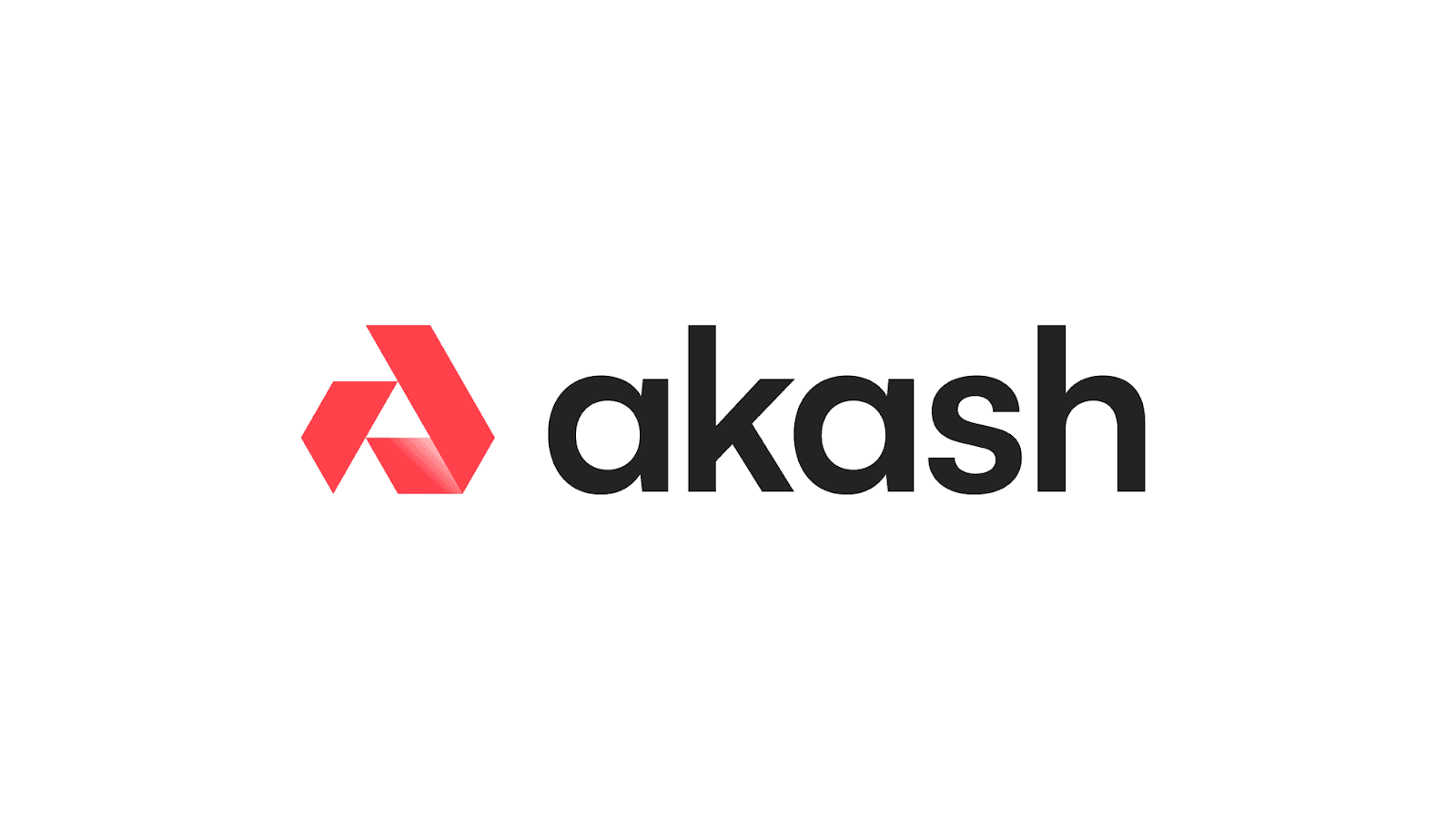
Akash Comparative Analysis
Akash represents an extremely strong blockchain-focused cloud computing platform. Although the reasons for this are many, the network's focus on decentralization, security, ease of use, and cost abatement are some of the most prominent features that have contributed to the network’s increased adoption.
As we initially touched on in our first Akash blog post in this series, most mega-conglomerate-built cloud computing platforms are extremely centralized. That being said, the current cloud compute landscape and the world we find ourselves in demands another alternative.
Thankfully, Akash is built to be open-source, decentralized, permissionless, and governed by the community, meaning every meeting, funding incentivization mechanism, and potential roadmap modification or product change is voted on by the community and takes place in person in a public setting.
Unfortunately, it's not just Big Tech cloud computing entities such as Amazon Web Services (AWS), Google Cloud, Hetzner, Microsoft Azure, and others that struggle with the many challenges that cloud platforms are susceptible to.
In fact, many cloud computing platforms in the blockchain and crypto realm suffer from many of the same inefficiencies that their larger non-crypto counterparts adhere to. To provide some additional context, below we’ll look at how some of Akash Network’s competitors struggle with centralization issues and a host of additional challenges.
Specifically, we’ll compare and contrast Akash to:
- Render Network
- io.net
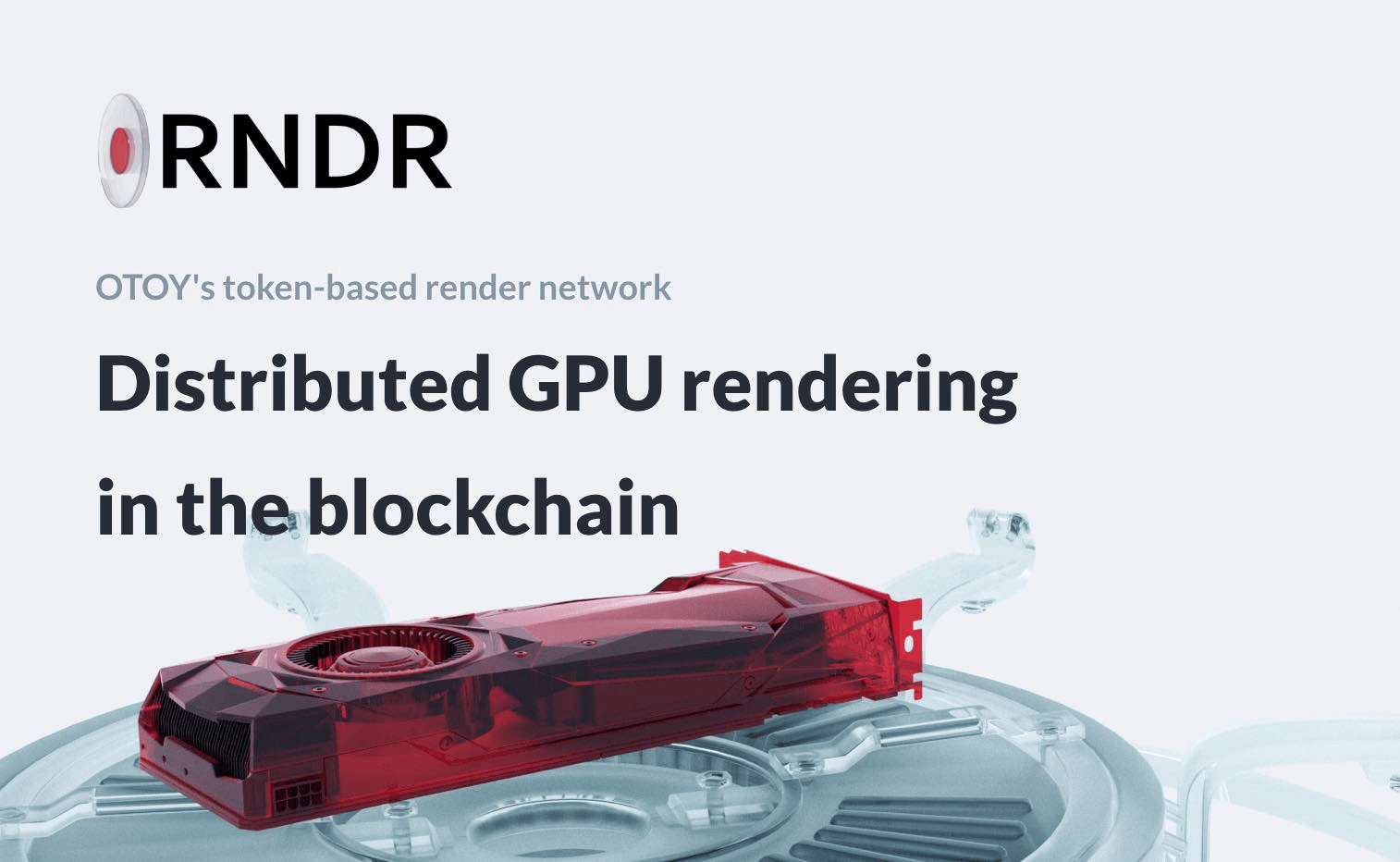
Render Network
Similarly to Akash Network, Render Network is a cloud computing network built specifically to offer a peer-to-peer (P2P) marketplace for GPU compute. Differently from Akash however, Render was built to be a network focused on providing computational capital for rendering via smart contracts.
Initially built by OTOY Inc. in 2009 prior to becoming a crypto- and blockchain-focused start-up, Render harnesses OTOY’s proprietary technology to furnish a compute marketplace between GPU providers (called Network Nodes) and GPU requestors (called Creators). This design allows the platform to monetize otherwise idle GPUs by offering their computational power to creators and artists who wish to leverage additional power needed for rendering.
While the platform was initially built as a marketplace for the rental of compute specifically for GPU rendering (for 3D CAD rendering), it has since expanded to serve a wide variety of real world uses including those related to artificial intelligence (AI), augmented reality (AR), mixed reality (MR), virtual reality (VR), media, gaming, and others.
Furthermore, Render Network’s 3D CAD-focused capacity can be used for various constructs related to project mapping, product design, architecture, and visualization for engineers, architects, designers, scientists, healthcare professionals, and the like.
Since inception, the Render Network operated on top of the Ethereum blockchain, employing the use of its proprietary RNDR token to help enable the functionality of the network. That said, after a community governance vote in 2023, community members chose to transition the platform away from Ethereum.
As of November 20203, the network operates on top of Solana. Along with this change, the protocol is also in the process of conducting a token migration where all existing ERC-20 RNDR tokens will be converted to the new SPL- and Solana-specific RENDER token. The launch introduced the Burn-and-Mint Equilibrium (BME) mechanism and enabled several new features including that ability to receive on-chain payments for rendering tasks in RENDER, more predictable job pricing, and incentivized rewards-based node participation.
One of the main problems with Render Network is that it is not decentralized. In fact, Render is permissioned in nature, meaning for a user to rent out their GPU and offer compute, they must be approved by the creators of the platform. Conversely, on Akash Network it is possible for anyone to lease their GPU compute capacity to other users without permission from the larger Akash network.
If users are unable to contribute to a service-specific network and must deal with unfounded restrictions, it's difficult to consider the network equitable in practice. Nonetheless, the fact remains that designs of this nature are susceptible to centralized manipulation where a select few individuals (or a single entity) garners full control over the network.
What’s more, in contrast to Akash, Render Network is also not designed to be open source. This means the network’s codebase is inaccessible to a potential party that would like to perform an audit, ultimately meaning that the platform does not allow others to build atop it or check code integrity for errors that could result in potential manipulation.
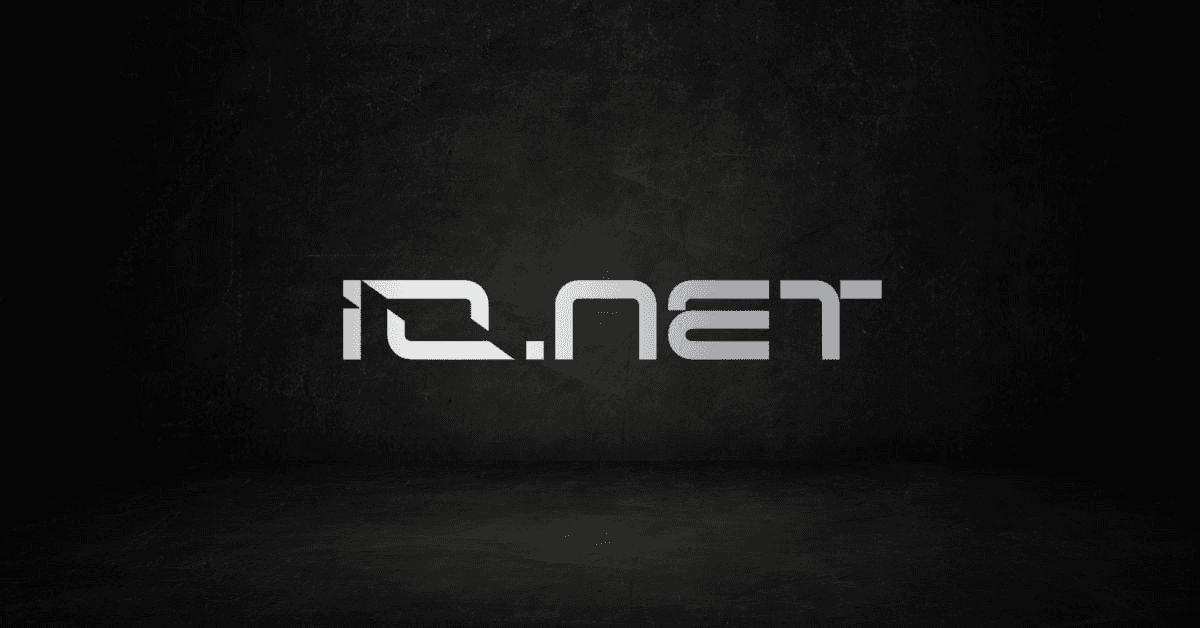
io.net
io.net is an enterprise-grade blockchain-focused computing network that provides accessibility to compute for machine learning and AI engineers and other related professionals. In particular, io.net offers computational accessibility via a network capable of creating distributed cloud clusters for thousands of GPUs via the serviceability of its IO token and numerous infrastructure layers whether co-located or geo-distributed. Unlike Akash Network, which is built to operate on Cosmos, the io.net platform operates solely on Solana.
The io.net platform is natively built atop ray.io, a state-of-the-art machine learning infrastructure for distributed computing systems. Recall that ray.io is the same framework used by open.ai to train Chat GPT across 300,000 CPUs and 20,000 GPUs. Therefore, io.net is able to distribute numerous AI and Python developer applications in various capacities including those related to reinforcement learning, deep learning, tuning, and model serving across an extensive grid of GPUs.
In general, the io.net framework offers compute accrual services on an hourly basis. In doing so, it's important that the network leverages a way to guarantee that GPU compute power is actually available when it's requested by a user. This is realized with the network’s Proof of Time-Lock (POTL) verification system that specifically utilizes cryptographic proof technology to verify that said GPUs were not accessed by another service during the predetermined rental time allocated to another customer.
io.net makes use of numerous independent data centers, crypto miners, and crypto DePIN platforms such as Render Network and Filecoin. Moreover, io.net leverages several interconnected components that allow the platform to operate as needed. These include:
- IOG Network - io.net’s main blockchain and decentralized physical infrastructure network consisting of a vast network of independently operated hardware nodes that provide permissionless GPU and CPU compute accessibility
- IO Cloud - a cloud platform that provides developers with the ability to virtualize scalable and configurable clusters via compute capacity from the IOG Network
- IO Worker - a easy-to-use web application that allows users to rent out their GPU and CPU compute capacity on the IOG Network
- IO-SDK - an open source SDK that allows developers to deploy various products and services atop the IOG Network.
- IO ID - a universal identity management solution for users of the IO ecosystem
io.net claims to be able to offer its services to users at a fraction of the cost compared to the costs levied by traditional Big Tech cloud service providers. Regardless, the network exhibits its fair share of challenges.
For example, as of August 2024, only 11.8% of the 800 million maximum IO token supply is currently in circulation, leading many to hypothesize the network was arguably tailored to fill the pockets of numerous large scale investors.
Case and point, the inequitable token distribution depicted in a recent Binance io.net report shows that a staggering 84% of the 500 million IO genesis token supply at TGE is allocated to the io.net founding team, its early investors, and other in-house participants.
Even the 16% community allocation is likely mainly reserved for marketplace serviceability for GPU rentals and under the network's control. Additionally, the network’s token release schedule is also fairly centralized because of the fact the circulating supply will jump from 11.8% today to approximately 73% by October 2027. In fact, according to the largest Solana blockchain explorer, Solscan, nearly 91% of the 500 million total tokens initially created upon launch are held by a single wallet.
Consequently, despite its strong technology and widespread capacity to provide compute in various capacities, it seems somewhat far-fetched that io.net will accrue long-term value comparable to more decentralized crypto-agnostic cloud computing platforms such as Akash Network and others.
Regulatory and Compliance Concerns
Although it seems unlikely that Akash will be the subject of regulatory scrutiny moving forward, like any open public blockchain employing crypto as part of its foundational design, the potential for unwanted regulatory challenges is possible.
This is especially true with the regulatory challenges the crypto industry and blockchain at large have faced in the United States and the fact that Overclock Labs, the parent entity behind the platform's development is US-based. That said, the regulatory issues that have stifled crypto’s adoption in the US for so long may soon be a thing of the past.
We have a long way to go in this regard, but it seems that with the upcoming US presidential election and the seemingly inevitable pro crypto regulation that could be on the horizon in the US, that the regulation-by-enforcement approach popularized by the Securities and Exchange Commission (SEC) may be shifting. This fact bodes well for Akash and hundreds of crypto-focused enterprises in the country, be they cloud-based or not.
However, a remote possibility exists that a large centralized cloud computing provider such as Microsoft Azure, AWS, or Google Cloud could utilize their power to try to stuff out the competition from smaller cloud service entities like Akash and others.
Nonetheless, this seems quite unlikely and it's probably more likely that blockchain and crypto-focused cloud computing platforms such as Akash will continue to forge partnerships with large scale traditional cloud providers the world over; even in an effort to consult with them on the implementation of strategies that will make their cloud infrastructures less centralized.
Akash Network's Long Term Potential
Akash represents a cutting edge blockchain-focused cloud computing platform that exhibits vast potential.
Specifically, Akash Network’s decentralized design, open-source infrastructure, permissionless serviceability, widespread availability, and low-cost model make the network a remarkably strong contender in the blockchain cloud computing niche.
By leveraging Akash, any type of cloud-native application is easily deployable without requiring it to be written in a new language or to be susceptible to restrictions such as vendor lock-ins. At the same time, because Akash employs the Cosmos SDK, the platform is designed to be interoperable with a wide range of blockchains built atop the larger Cosmos ecosystem, unlocking the ability to share data and assets in an unabated manner.
Furthermore, the Akash Network’s incentivized provider-tenant model (which we covered in greater detail in our second blog post in the series) allows for the accrual of revenue for those hosting compute infrastructure, while simultaneously allowing users to obtain the data they need at a fraction of the cost compared to most alternatives, be they centralized or otherwise.
By utilizing this model, bids for cloud services are autonomously matched with offers via mechanisms that allow the AKT token to be incorporated into critical network processes such as staking, governance, transaction processing, and protocol-level incentivization.
This is noteworthy because of the fact that global data centers typically leverage their entire computing resource bandwidth without heed, meaning that those seeking resources may face a host of challenges when interacting with centralized cloud service providers. Thankfully, Akash provides a more equitable alternative to such models.
In opposition to the centralized ethos of industry tech giants, Akash offers a platform focused on unalterable data privacy, service transparency, and immutability from centralized control, while democratizing secure censorship-resistant app deployment.
Because of the points touched on above and a host of additional considerations, Akash Network represents a cloud compute paradigm focused on shaping the long-term viability of decentralized cloud infrastructure in a way that allows all of us to share our computational serviceability in an egalitarian manner.
Resources
The information provided by DAIC, including but not limited to research, analysis, data, or other content, is offered solely for informational purposes and does not constitute investment advice, financial advice, trading advice, or any other type of advice. DAIC does not recommend the purchase, sale, or holding of any cryptocurrency or other investment.
